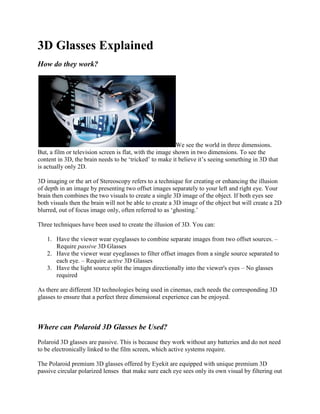
How 3D Glasses Work
- 1. 3D Glasses Explained How do they work? We see the world in three dimensions. But, a film or television screen is flat, with the image shown in two dimensions. To see the content in 3D, the brain needs to be ‘tricked’ to make it believe it’s seeing something in 3D that is actually only 2D. 3D imaging or the art of Stereoscopy refers to a technique for creating or enhancing the illusion of depth in an image by presenting two offset images separately to your left and right eye. Your brain then combines the two visuals to create a single 3D image of the object. If both eyes see both visuals then the brain will not be able to create a 3D image of the object but will create a 2D blurred, out of focus image only, often referred to as ‘ghosting.’ Three techniques have been used to create the illusion of 3D. You can: 1. Have the viewer wear eyeglasses to combine separate images from two offset sources. – Require passive 3D Glasses 2. Have the viewer wear eyeglasses to filter offset images from a single source separated to each eye. – Require active 3D Glasses 3. Have the light source split the images directionally into the viewer's eyes – No glasses required As there are different 3D technologies being used in cinemas, each needs the corresponding 3D glasses to ensure that a perfect three dimensional experience can be enjoyed. Where can Polaroid 3D Glasses be Used? Polaroid 3D glasses are passive. This is because they work without any batteries and do not need to be electronically linked to the film screen, which active systems require. The Polaroid premium 3D glasses offered by Eyekit are equipped with unique premium 3D passive circular polarized lenses that make sure each eye sees only its own visual by filtering out
- 2. for one eye the visual that is meant for the other. This is where Polaroid 3D glasses perform so well to give a perfect 3D experience. They are designed to be used with circular polarizing technology - the most popular technology in cinemas today (IMAX, Odeon, ABC, VUE, Empire), passive 3D TV’s and pubs showing Sky 3D Sports. These use systems such as RealD™, masterimage and Technicolor. Where would I use Active 3D Glasses? Active 3D glasses are usually associated with home viewing i.e. with 3D TV's (LG Panasonic, Samsung, Sony,), Laptops or PC's (, ATI Tech, Bit Cauldron, NVidia 3D Vision). They are used with screens that are compatible with active shutter technology providing 2D images that alternative. The screens contain a transmitter that synchronizes with active shutter glasses. These glasses contain electronic components that are constantly blacking out either the left or right lens, so that one image is shown to one eye and one to the other. These glasses are usually brand specific so if you have Panasonic 3D glasses, they will only work with a Panasonic TV. Why choose Polaroid 3D glasses above other brands? A passive circular-polarized 3D lens is made up of two key components – a linear polarizer and a clear retarder layer. When forming the lenses for other 3D glasses, these components can become damaged. The polarizers can lose efficiency when subjected to the high temperatures required in the forming process, and the ‘stretching’ of the lenses to give them their properties can show up as stress when viewing a 3D film, which takes away the enjoyment of the film. Polaroid 3D glasses have the advantage of Polaroid Eyewear’s decades of experience and superior knowledge of producing premium polarized lenses. The 3D lenses are made with Thermofusion™ Technology for distortion- free vision. It’s a step forward in optical manufacturing. Their technology is also flexible enough to create lenses with widely different curvatures and the same careful optical fine-tuning. This means you can experience unblemished, perfect 3D vision with Polaroid 3D glasses, even in wraparound 3D styles. Can Polaroid 3D Glasses be Used Outdoors? Even though the lenses in these 3D glasses include UV protection, Polaroid Eyewear don’t recommend their 3D glasses for extended outdoor usage as the different attributes that provide the 3D vision are different from those used for sunglasses with full UV protection. Also, these glasses should not be used for driving or as safety glasses; they’re simply made for your enjoyment watching 3D films!
- 3. Can I watch 3D movies on my normal TV? No, normal TV's are not capable of polarisation and cannot generate the offset images require